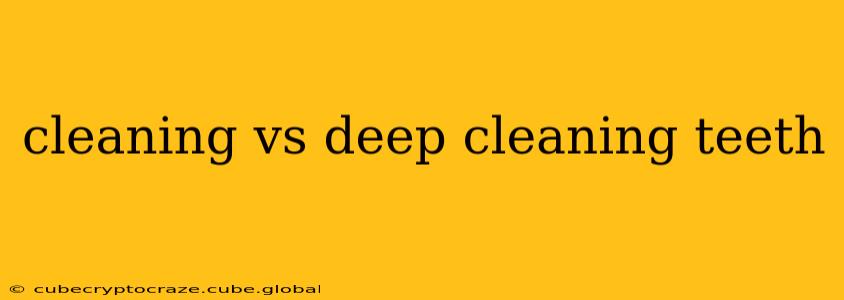Maintaining optimal oral hygiene is crucial for overall health. However, the terms "cleaning" and "deep cleaning" often cause confusion. This comprehensive guide clarifies the distinctions between these two essential dental procedures, helping you understand when each is necessary and how to best protect your smile.
What is a Regular Teeth Cleaning?
A regular teeth cleaning, also known as a prophylaxis, is a preventative procedure performed by a dental hygienist. It focuses on removing plaque and tartar buildup from the surfaces of your teeth. This involves:
- Professional Cleaning: Using specialized tools, your hygienist meticulously removes plaque (a sticky film of bacteria) and tartar (hardened plaque) above the gum line.
- Polishing: After removing plaque and tartar, your teeth are polished to create a smooth surface, making it more difficult for plaque to adhere.
- Fluoride Treatment: A fluoride treatment is often applied to strengthen tooth enamel and prevent cavities.
- Oral Health Education: Your hygienist will provide personalized advice on brushing, flossing, and maintaining optimal oral hygiene at home.
Regular cleanings, typically recommended every six months, are crucial for preventing gingivitis (gum inflammation) and cavities. They're a vital part of preventative care and significantly reduce the risk of more serious dental problems.
What is a Deep Cleaning (Scaling and Root Planing)?
A deep cleaning, technically called scaling and root planing, addresses periodontal disease (gum disease). Unlike a regular cleaning, it involves:
- Deep Scaling: Removing plaque and tartar from below the gum line, where it's inaccessible with regular brushing and flossing. Special instruments are used to carefully clean the root surfaces of the teeth.
- Root Planing: Smoothing the tooth roots to remove bacteria and toxins that contribute to gum inflammation and infection. This helps the gums reattach to the teeth.
Deep cleanings are typically performed over two appointments, one for the upper teeth and one for the lower teeth. They require local anesthesia to ensure comfort during the procedure.
How Often Should I Get a Deep Cleaning?
The frequency of deep cleanings depends entirely on the severity and progression of your periodontal disease. Your dentist will assess your individual needs and recommend a schedule that may range from once a year to more frequently, if necessary. Regular check-ups and cleanings are essential in catching gum disease early and preventing the need for more extensive treatment.
People Also Ask: What are the signs I need a deep cleaning?
Several signs may indicate you require a deep cleaning. These include:
- Bleeding gums: Persistent bleeding while brushing or flossing is a common warning sign of gum inflammation.
- Swollen or red gums: Inflamed gums are often indicative of gingivitis, which can progress to periodontitis without proper treatment.
- Receding gums: Gum recession exposes the tooth roots, making them vulnerable to decay and infection.
- Persistent bad breath: Halitosis (bad breath) can sometimes be a sign of underlying oral health issues, including periodontal disease.
- Loose teeth: In advanced stages of periodontal disease, teeth may become loose and eventually fall out.
People Also Ask: Does a deep cleaning hurt?
While some discomfort is possible, most patients report minimal pain thanks to local anesthesia. Any post-procedure soreness is usually mild and can be managed with over-the-counter pain relievers.
People Also Ask: How long does a deep cleaning take?
A deep cleaning typically requires two appointments, each lasting approximately one to two hours, depending on the extent of the treatment.
People Also Ask: How much does a deep cleaning cost?
The cost of a deep cleaning varies depending on your location, the dentist, and the extent of the treatment required. It's generally more expensive than a regular cleaning, but it is a critical investment in your long-term oral health.
People Also Ask: Is a deep cleaning the same as a root canal?
No, a deep cleaning and a root canal are different procedures. A deep cleaning addresses gum disease, while a root canal treats a tooth with an infected pulp. They can be separate or sometimes related treatments.
In conclusion, regular cleanings and deep cleanings are both integral parts of maintaining healthy teeth and gums. Regular check-ups and diligent oral hygiene at home are crucial for preventing the need for more extensive procedures and ensuring a lifetime of healthy smiles. Remember to consult with your dentist regularly to determine the appropriate cleaning schedule for your individual needs.
